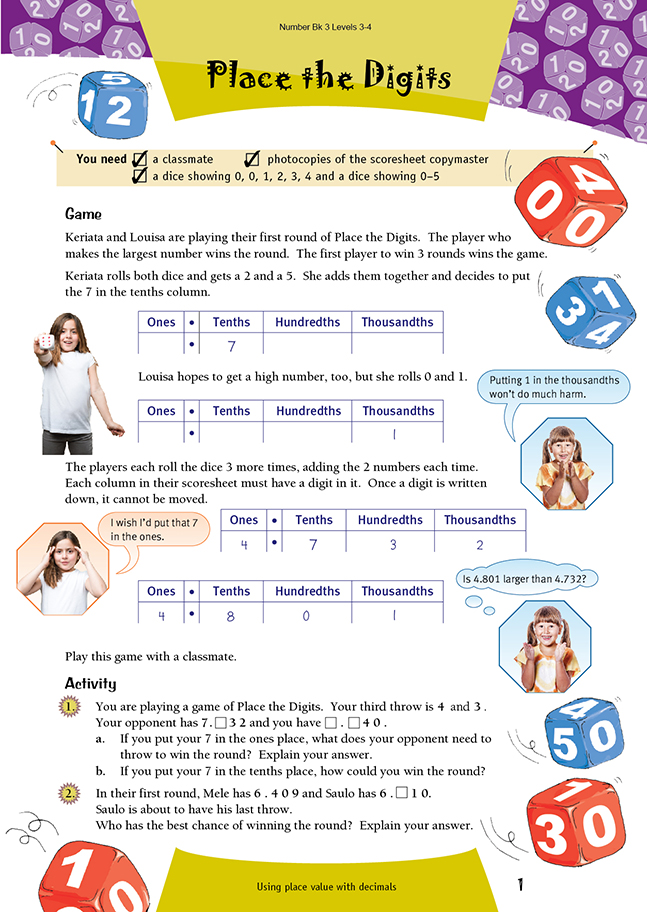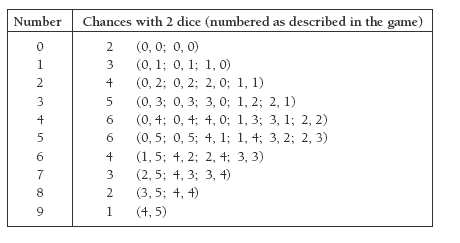This is a level 4 number activity from the Figure It Out series. It relates to Stage 7 of the Number Framework.
A PDF of the student activity is included.
Click on the image to enlarge it. Click again to close. Download PDF (371 KB)
order decimals to3 decimal places
A dice showing 0, 0, 1, 2, 3, 4 and a dice showing 0-5
FIO, Level 3-4, Number, Book 3, Place the Digits, page 1
A classmate
Scoresheet (see Copymaster)
This game involves placing numbers to 3 decimal places (that is, to thousandths) and requires the students to engage in strategic thinking about place value. The development of decimal knowledge begins at the advanced additive stage of the Number Framework. In each round, the students try to create the largest possible number in 4 throws of the 2 dice, so they have to decide in which column to record the result of each throw. Each decision will probably depend on the student’s
idea about how likely it is that they will throw higher or lower numbers (with both dice) in their remaining throws.
The key learning outcomes of this game are understanding place value and simple probability, in this case, using decimals. There is a lot of scope here for discussion and investigation regarding the effect of placing a digit in different columns, for example, the tenths column rather than the hundredths column. The students need to understand that, in decimals, as with whole numbers, each column to the left is 10 times greater than the previous column and each column to the right is 10 times less than the previous one. For example, 0.6 is 10 times greater than 0.06, and 0.006
is 10 times less than 0.06.
Once the students understand the importance of place value in this game, they could investigate the likelihood of rolling digits that add up to each of the numbers 0–9. The chances could be set out in a table, as below:
There are 36 possible combinations of the 2 dice. Once these combinations have been worked out, the students may then be able to see that they have 20 chances of scoring a total less than 5 but only half that number of chances (10) of scoring a total greater than 5. (They have 6 chances of scoring 5.) This may help them to think strategically as they play the game. (A variation of the game could be to create the smallest possible number.)
Activity
This activity draws on the students’ understanding of statistics as well as place value. Working out the chances of throwing each number from 0 to 9, as described above, will help the students to answer these questions.
The throws needed for question 1 are explained in the Answers. The focus of this question is on place value rather than on probability.
To win the game described in question 2, Saulo has to throw a 4 or more. You may want to discuss this with the students to make sure they understand that 6.410 (or 6.510, 6.610, and so on) is higher than 6.409. (This is particularly relevant if Saulo throws a 4.) The students therefore need to work out the chance of Saulo throwing a 4 or more. The table above shows that Saulo has a (6 + 6 + 4 + 3 + 2 + 1)/36 chance, that is, a 22/36 or 11/18 chance of winning.
Answers to Activities
Game
A game using place value with decimals
Activity
1. a. Your opponent has to score higher than you because your 4 in the hundredths place is higher than your opponent’s 3.
b. You will win outright if you score 8 or 9 on your next throw (which will beat your
opponent’s 7 in the ones place). If you score 7, you will still win if your opponent throws 7 or less. If you throw less than 7, you will lose no matter what your opponent throws.
2. Saulo. He needs to get a 4 or more to win the round. There are 36 possible combinations of the 2 dice, and Saulo has a 22/36 chance of getting a 4 or more. Mele’s chances of winning are 14/36. (That is, there is a 14/36 chance of Saulo not
getting a 4 or more, in which case, Mele would win.)

